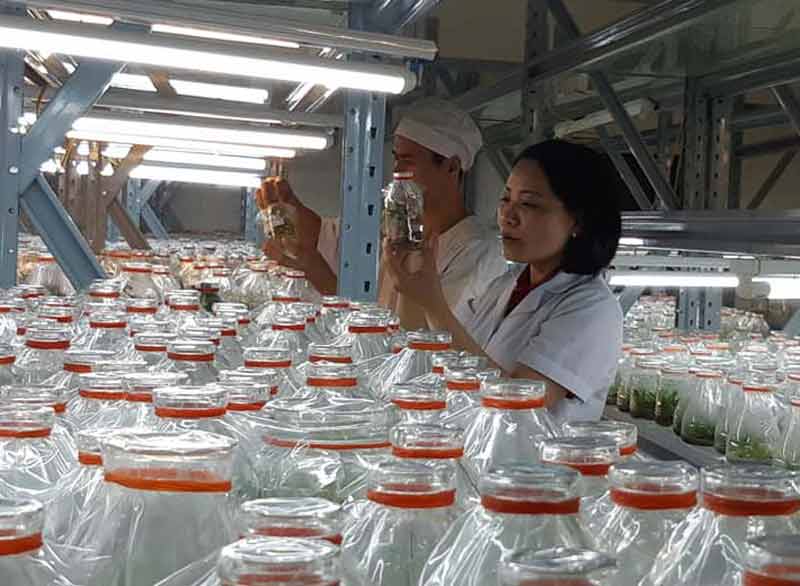
(HBO) - In July 2013, Hoa Binh Biopharm joint Stock Company was established in Group 17, Tan Thinh Ward (Hoa Binh City). The company has invested 3 tissue culture rooms, 3 net houses, and a garden to preserve and test the production process with total area of nearly 8 hectares and equipment. In 2013, this is the first tissue culture room that invested by private enterprises in Hoa Binh province and in the pharmaceutical companies in the Northern region.
 Tissue culture room of Biopharm Hoa Binh joint Stock Company.
Tissue culture room of Biopharm Hoa Binh joint Stock Company.
The theory of tissue culture technology is already in the book, but each plant has its own breeding process. So when the Company started to work, it was difficult. Most valuable medicinal plants are wild species without the propagation manual. Many trees are in the "Vietnam Red Book". So it is necessary a lot of intelligence and energy.
Many times, thousands of vases have been discarded, but with perseverance, the manipulations and conditions for each stage of each type of plant is sketched by the Company. However, it also takes about 2 - 3 years to study a complete process that is appropriate when taken out in the wild.
So far, Hoa Binh Biopharm Company has mastered more than 20 technological processes of breeding and cultivating precious medicinal plants. On April 10, 2014, the company was granted Certificate No. 01 by the Department of Science and Technology as the first science and technology enterprise of Hoa Binh province.
With outstanding quality from newly researched technology, many public and private units and organizations throughout and outside the province know the company and order transfer process. The company has transferred the technology of breeding and cultivating more than 10 precious medicinal plants to units.
Especially, in 2015, the Company successfully researched the propagation process, cultivating Cordyceps fungus on organic matter by invitro technology. According to the test results of Hanoi Medical University, the active ingredient of Cordyceps fungus is grown by the company stable and higher than the pharmacopoeia.
Each year, the company cultivates hundreds of kilograms of fresh Cordyceps mushrooms to serve raw materials for producing medicines and functional foods for a number of reputable domestic pharmaceutical companies. The company also cultivates a number of medicinal plants that have studied the process, solving the situation of scarcity of this plant material in nature.
The company gradually affirmed its prestige. Research results, applications of the company are breakthrough, contributing to science, reasoning and practice.
According to data from the Hoa Binh Provincial Party Committee, the industrial production index for the first six months of 2025 is estimated to have increased by 20% compared to the same period last year. This marks the highest year-on-year growth rate for this period since 2020.
In the first six months of 2025, Hoa Binh province’s export turnover was estimated at 1.145 billion USD, marking an 18.11% increase compared to the same period in 2024. Import turnover was estimated at $ 804 million, a 17.15% increase, which helped the province maintain a positive trade balance.
The lives of the ethnic minority farmers in Tan Lac district have gradually improved thanks to the new directions in agricultural production. This is a testament to the collective strength fostered through the professional associations and groups implemented by various levels of the district’s Farmers’ Union.
With the motto the "product quality comes first,” after nearly one year of establishment and operation, Muong village’s Clean Food Agricultural and Commercial Cooperative, located in Cau Hamlet, Hung Son Commune (Kim Boi district), has launched reputable, high-quality agricultural products to the market that are well-received by consumers. The products such as Muong village’s pork sausage, salt-cured chicken, and salt-cured pork hocks have gradually carved out a place in the market and they are on the path to obtaining the OCOP certification.
In the past, the phrase "bumper harvest, rock-bottom prices" was a familiar refrain for Vietnamese farmers engaged in fragmented, small-scale agriculture. But today, a new spirit is emerging across rural areas of Hoa Binh province - one of collaboration, organisation, and collective economic models that provide a stable foundation for production.
Maintaining growing area codes and packing facility codes in accordance with regulations is a mandatory requirement for agricultural products to be eligible for export. Recently, the Department of Agriculture and Environment of Hoa Binh province has intensified technical supervision of designated farming areas and packing facilities to safeguard the "green passport" that enables its products to access international markets.



 Tissue culture room of Biopharm Hoa Binh joint Stock Company.
Tissue culture room of Biopharm Hoa Binh joint Stock Company.